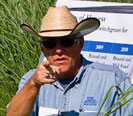
Vanessa Corriher-Olson
Forage Specialist
Texas A&M AgriLife Extension
Most of Texas has had some rainfall this spring. However, the Panhandle, the rolling plains, and West Texas are abnormally dry or have moderate drought conditions. High winds and dry conditions have unfortunately increased chances for wildfires in those areas.
In East Texas, pastures are bountiful with annual ryegrass and clovers. Some will soon be harvested for baleage or for hay. Small grain forages were unsuccessful this past season in some areas due to environmental conditions. However, winter wheat has done reasonably well in the Panhandle, central Texas and the Coastal Bend.
Bermudagrass has started greening up in some parts of the state (southeast and central Texas). However, cooler night temperatures in northeast Texas continue to delay bermudagrass green up. In the Coastal Bend, high winds have depleted much of the topsoil moisture. Corn, grain sorghum, and cotton were doing well but now suffer due to low soil moisture. In central Texas, corn and sorghum have been planted with timely rainfalls.

Ray Smith
Extension Forage Specialist
University of Kentucky

Tom Keene
Extension Hay Specialist
University of Kentucky
Kentucky, like many other states, had above average temperatures throughout the late fall and winter. Alfalfa growth a month ago appeared headed to an unusual early harvest date, but below normal temperatures during early April slowed growth considerably. Several hard freezes caused tip burn but are unlikely to affect yield. The mild winter allowed alfalfa weevils to continue laying eggs through much of the winter, so damage was more severe than normal on many fields and there were unusual patterns (like severe damage on some fall seeded stands). Spraying has addressed most damage situations, but IPM assessments were difficult with highly variable growing degree days.
Grass hayfields and pastures have come through the winter overall in good shape. The mild winter seems to have resulted in higher than normal nitrogen losses as evidenced by poor vigor in many grass stands. Legume/grass hay and pasture stands and those with timely nitrogen applications should produce normal yields. Silage wheat stands should be closely monitored over the next five days to determine if the recent freezes reduced potential yields.
Moisture has been adequate across the state with the exception of an “abnormally dry” strip across several counties in central Kentucky. Forage producers are being encouraged to watch the weather closely for good hay harvest windows. Last year, the “early birds” had excellent quality hay, while those who waited struggled with finding timely windows for cutting, curing, and baling. One of the best websites for anywhere in the country is http://wwwagwx.ca.uky.edu/. Just type a zip code in the upper left-hand corner and a very detailed forecast will appear.

Jessica Williamson
Extension Forage Specialist
Penn State University
The cold snap over the past few weeks slowed down the forage growth from what we saw during the warm days of mid- to late-March. Recent warm, sunny days followed by some rain last week have caused pastures and hayfields to jump.
Things are still slow in the northern tier of Pennsylvania, but central and southern Pennsylvania farmers have been busy spreading fertilizer and planting perennials. Cool-season annuals over-wintered well with our mild winter and have benefitted from the recent rain and warm temperatures. If planning to be grazed, these cool-season annuals will soon be able to have livestock turned out, but annuals that will be removed for silage are still weeks away from being harvested.

